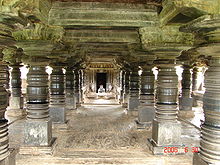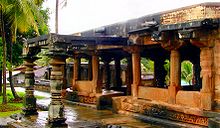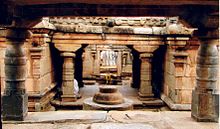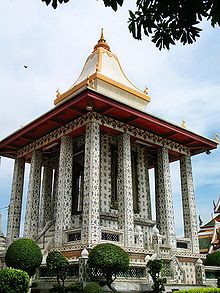- Mandapa
-
A mandapa (मंडप in Hindi/Sanskrit, also spelled mantapa or mandapam) in Indian architecture is a pillared outdoor hall or pavilion for public rituals.[1]
Contents
Temple architecture
In the Hindu temple the mandapa is a porch-like structure through the (gopuram) (ornate gateway) and leading to the temple. It is used for religious dancing and music and is part of the basic temple compound.[2] The prayer hall was generally built in front of the temple's sanctum sanctorum (garbhagriha). A large temple would have many mandapas.[3]
If a temple has more than one mandapa, each one is allocated for a different function and given a name to reflect its use. For example, a mandapa dedicated to divine marriage is referred to as a kalyana mandapa.[4] Often the hall was pillared and the pillars adorned with intricate carvings.[5] In contemporary terms, it also represents a structure within which a Hindu wedding is performed. The Bride & Groom encircle a holy fire lit by the officiating priest in the center of the Mandapa.[1]
Name variations
When a temple has more than one mandapa, they are given different names.[3]
- gMaha
- mandapa
- Ranga Mandapa
- Meghanath Mandapa
- Namaskara Mandapa
- Kalyana Mandapa
- Open Mandapa
- Jagamohan.
- Artha Mandapam — intermediary space between the sanctum sanctorum and the temple exterior
- Asthana Mandapam — assembly hall
- Kalyana Mandapam — dedicated to ritual marriage celebration of the Lord with Goddess
- Maha Mandapam — big hall for conducting religious discourses
Other languages
In Tamil, this platform is the Aayiram Kaal Mandapam - a distinctly thousand pillared hall close to the vimana of the Koil which forms a distinct part of the site plan of classical Dravidian architecture.
The Burmese term mandat (မဏ္ဍပ်), which has etymological origins in Pali mandapa, is an open platform or pavilion from which people spray water to passers-by during the Buddhist festival Thingyan.
A mandapa in Thai is a mondop. It features often in Thai temple art and architecture, either in the form of a Hor Trai (a temple library) or as an altar shrine such as the one in Wat Chiang Man in Chiang Mai.
Notes
- ^ Thapar, Binda (2004). Introduction to Indian Architecture. Singapore: Periplus Editions. p. 143. ISBN 0-7946-0011-5.
- ^ Ching, Francis D.K. (1995). A Visual Dictionary of Architecture. New York: John Wiley and Sons. p. 253. ISBN 0-471-82451-3.
- ^ a b "Architecture of the Indian Subcontinent - Glossary". http://www.indoarch.org/arch_glossary.php. Retrieved 2007-01-08.
- ^ Thapar, Binda (2004). Introduction to Indian Architecture. Singapore: Periplus Editions. p. 43. ISBN 0-7946-0011-5.
- ^ "Glossary of Indian Art". art-and-archaeology.com. http://www.art-and-archaeology.com/india/glossary1.html. Retrieved 2007-01-08.
See also
- Wedding mandap
External links
- Photo of four-pillared Kakatiya mandapa
- Photo of relief in a mandapa
- Floor plan of North Indian temple with mandapa
Categories:- Indian architecture
- Sanskrit words and phrases
- Hindu temple architecture
- Architecture stubs
Wikimedia Foundation. 2010.




